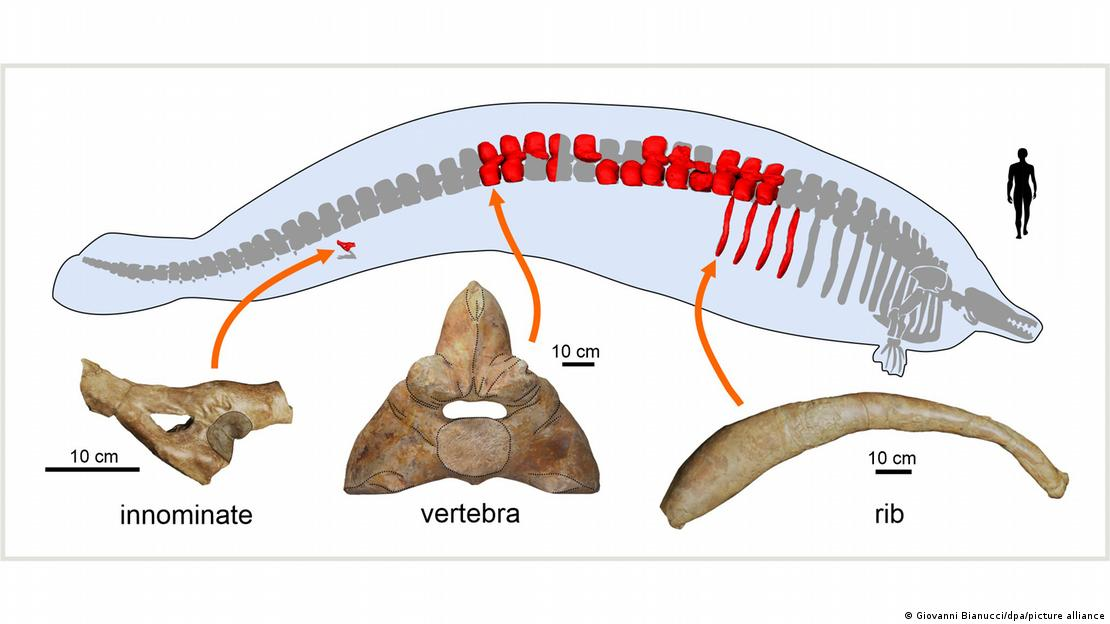Scientists have described fossils that are believed to have belonged to an extinct whale that may have been heavier than any other creature, including the largest dinosaurs.
The giant bones were discovered more than a decade ago in southern Peru and on Wednesday, after years of analysis, researchers finally named the creature Perucetus colossus, or “the colossal whale from Peru.”
The title of heaviest known animal — living or extinct — previously belonged to the blue whale.
Not guaranteed to be heavier, but it’s deemed likely
Perucetus is believed to have been around 20 meters (66 feet) long and to have weighed up to 340 metric tons.
In comparison, the heaviest blue whale ever recorded weighed 180 metric tons, according to Guinness World Records.
Although the researchers could only issue a very broad estimate range for the animal’s weight with the information at hand — somewhere between 85 and 340 tons — they noted that the mid-point of this range was heavier than any blue whale, and also said they had no reason to believe the fossil remains hailed from the largest Perucetus colossus ever to have lived.
“The main feature of this animal is certainly the extreme weight, which suggests that evolution can generate organisms that have characteristics that go beyond our imagination,” said paleontologist Giovanni Bianucci of the University of Pisa in Italy, and the lead author of the research published in the journal Nature.

What else do we know about Perucetus colossus?
The researchers had only a few fossilized bones to go by: 13 vertebrae, four ribs and one hip bone, all estimated to be 39 million years old.
Each vertebra weighs more than 100 kilograms (220 pounds) and the rib bones measure nearly 1.4 meters (5 feet) long.
“This is — for sure — the heaviest skeleton of any mammal known to date,” as well as any aquatic animal, said Eli Amson, a paleontologist at the State Museum of Natural History in Stuttgart, Germany, and another of the study’s co-authors.
The heavy skeleton is believed to have been necessary to counter the buoyancy of its vast blubber-filled body and oxygen-filled lungs, so that it would not be stuck floating on the surface unable to submerge.

Because no cranial or tooth remains were uncovered, it is difficult to determine what Perucetus ate.
However, some of the researchers believe Peruceetus was not an active predator but fed near the seabed of shallow coastal waters like sirenians — the family of animals including dugongs and manatees.
“Because of its heavy skeleton and, most likely, its very voluminous body, this animal was certainly a slow swimmer,” said paleontologist Olivier Lambert of the Royal Belgian Institute of Natural Sciences in Brussels and another of the study’s co-authors.
“This appears to me, at this stage of our knowledge, as a kind of peaceful giant, a bit like a super-sized manatee. It must have been a very impressive animal, but maybe not so scary.”
“Heavier than any other creature, including the dinosaurs”… this author doesn’t seem to know that blue whales are heavier than any of the dinosaurs.
I know that they don’t have an actual skull for the creature but I wonder how that tiny (comparatively) little head could support eating enough food to maintain a 760,000 pound animal. Especially if it can’t hunt because it is such a slow swimmer
So if I understand correctly, you’re mom is an ancient Peruvian whale.
Good thing it was friendly! (Supposedly… unless it had a bad night of sleep)
80 to 340 tons is a significant range. Sounds more like they’re trying to build hype than they actually know.
These wild weight guesstimations are common with large incomplete fossils. Scientists gain nothing from building up hype about some species, they just need to remain as speculative as possible so as to not mislead any future research or findings. If they narrowed down the rang they would have to back up their reasoning, and since they don’t have enough evidence their credibility would be lost.
Nah that’s viral marketing for Meg 2
Imagine time-traveling. Even for 5 secs. That would be a hell of a sight.
We all time travel for 5 seconds every 5 seconds at a rate of 1 second per second.
Relatively speaking, of course.







